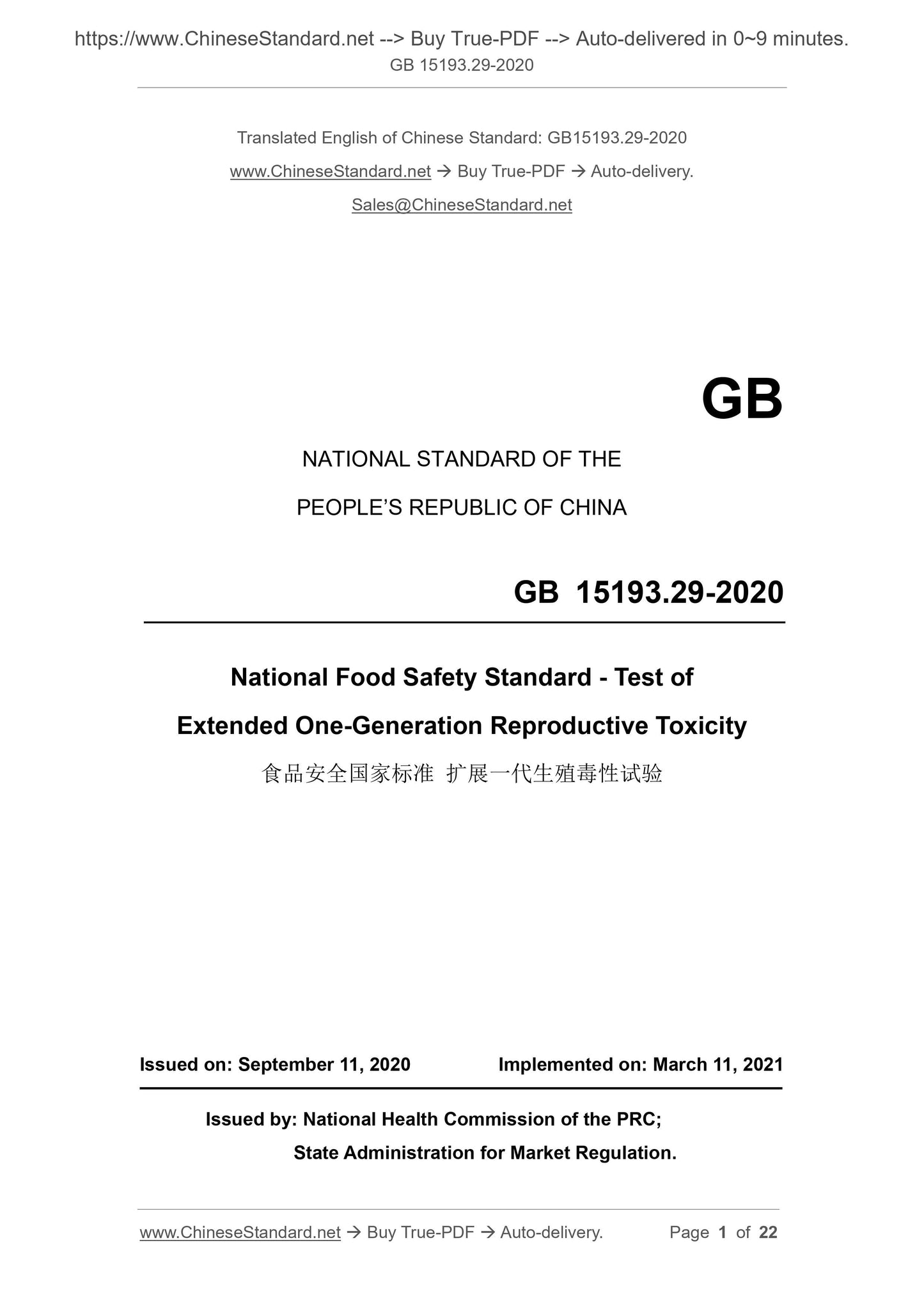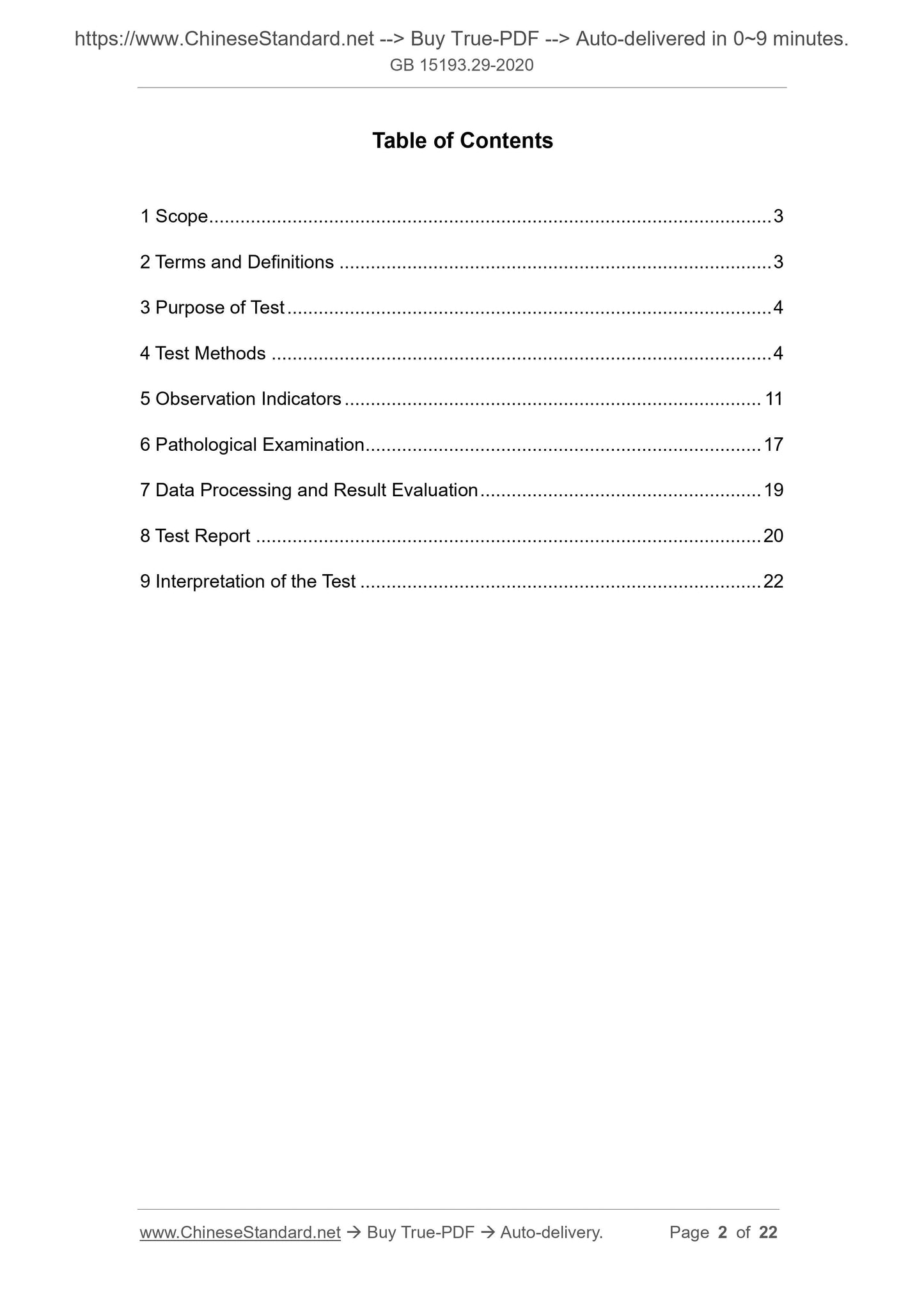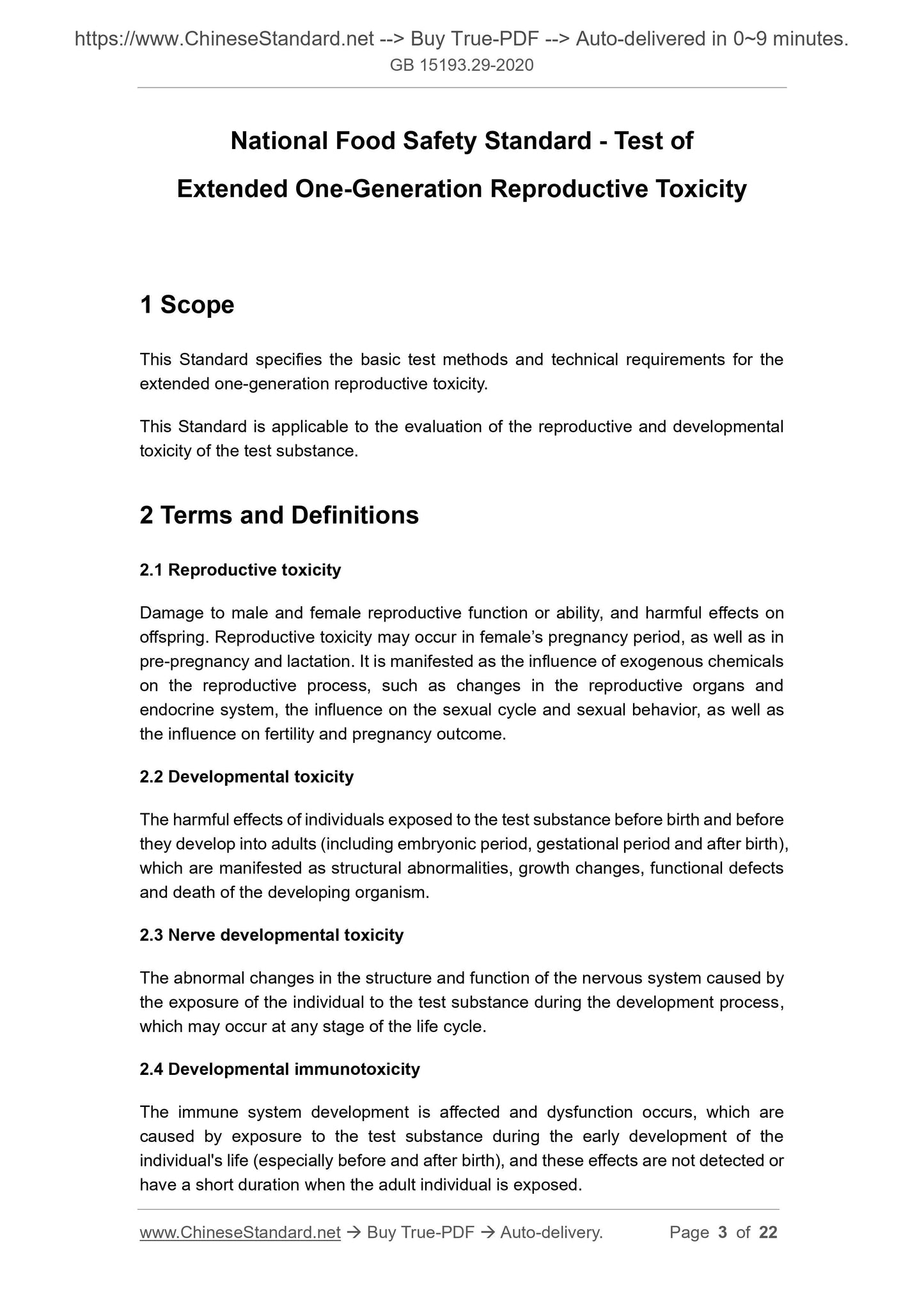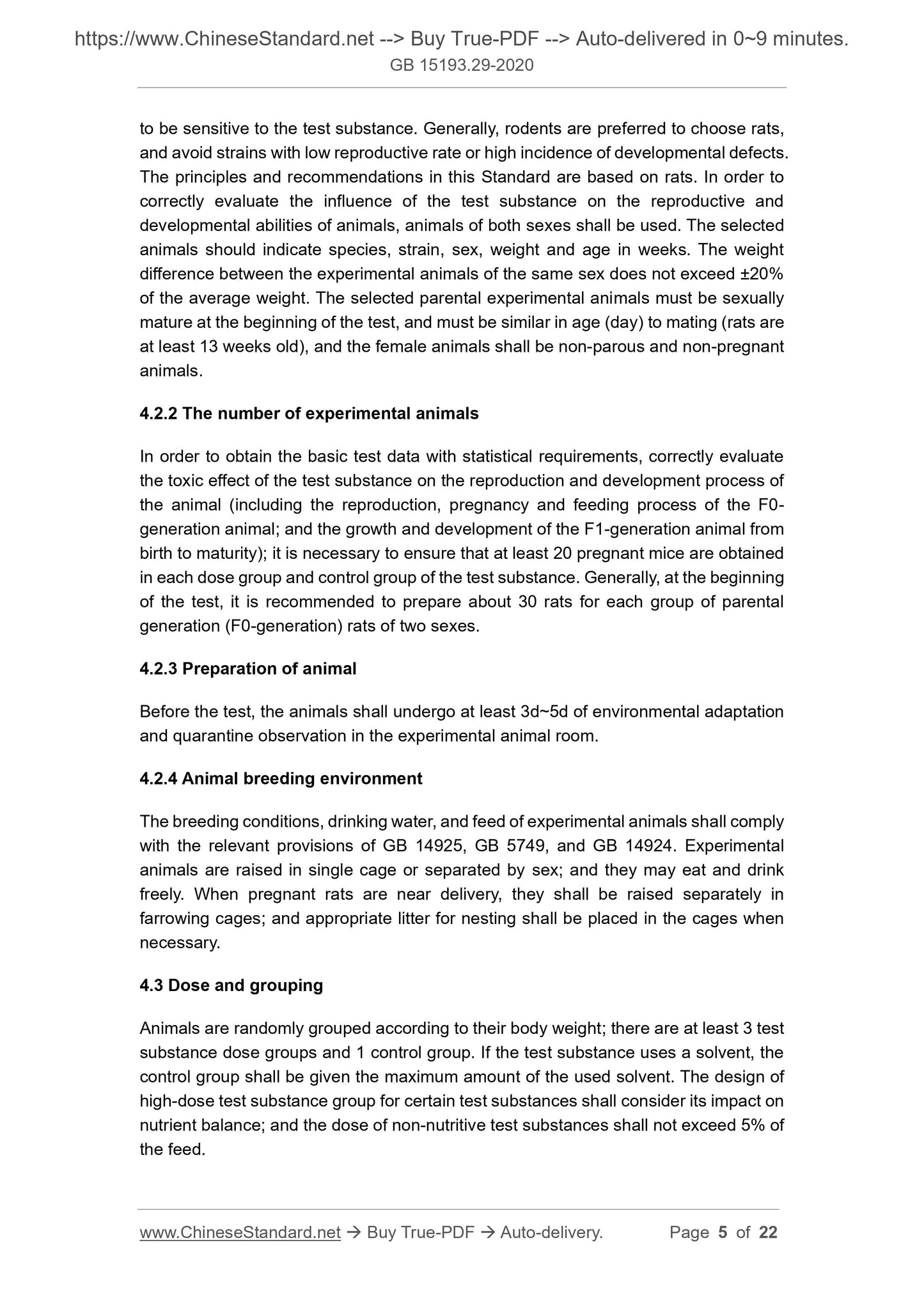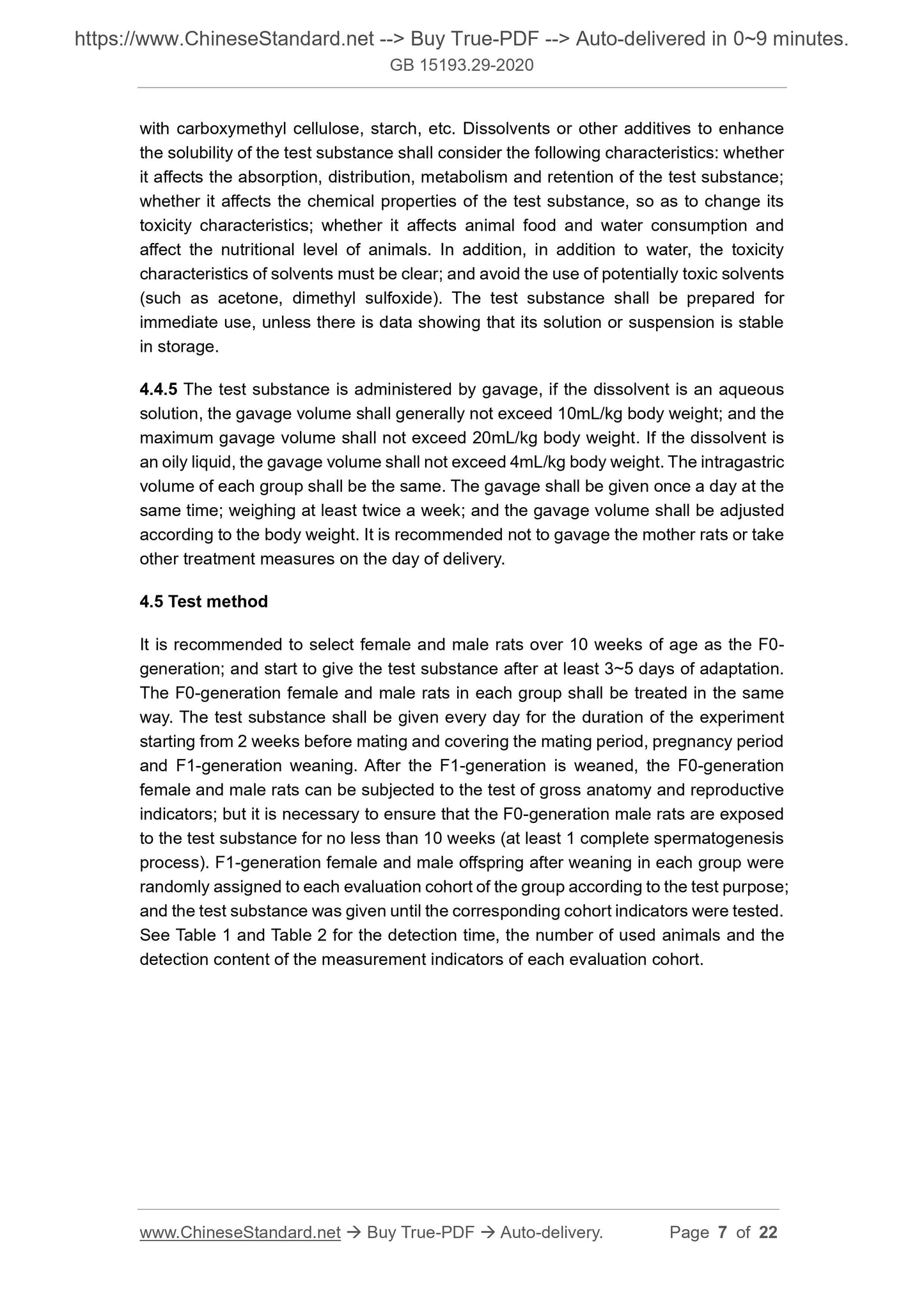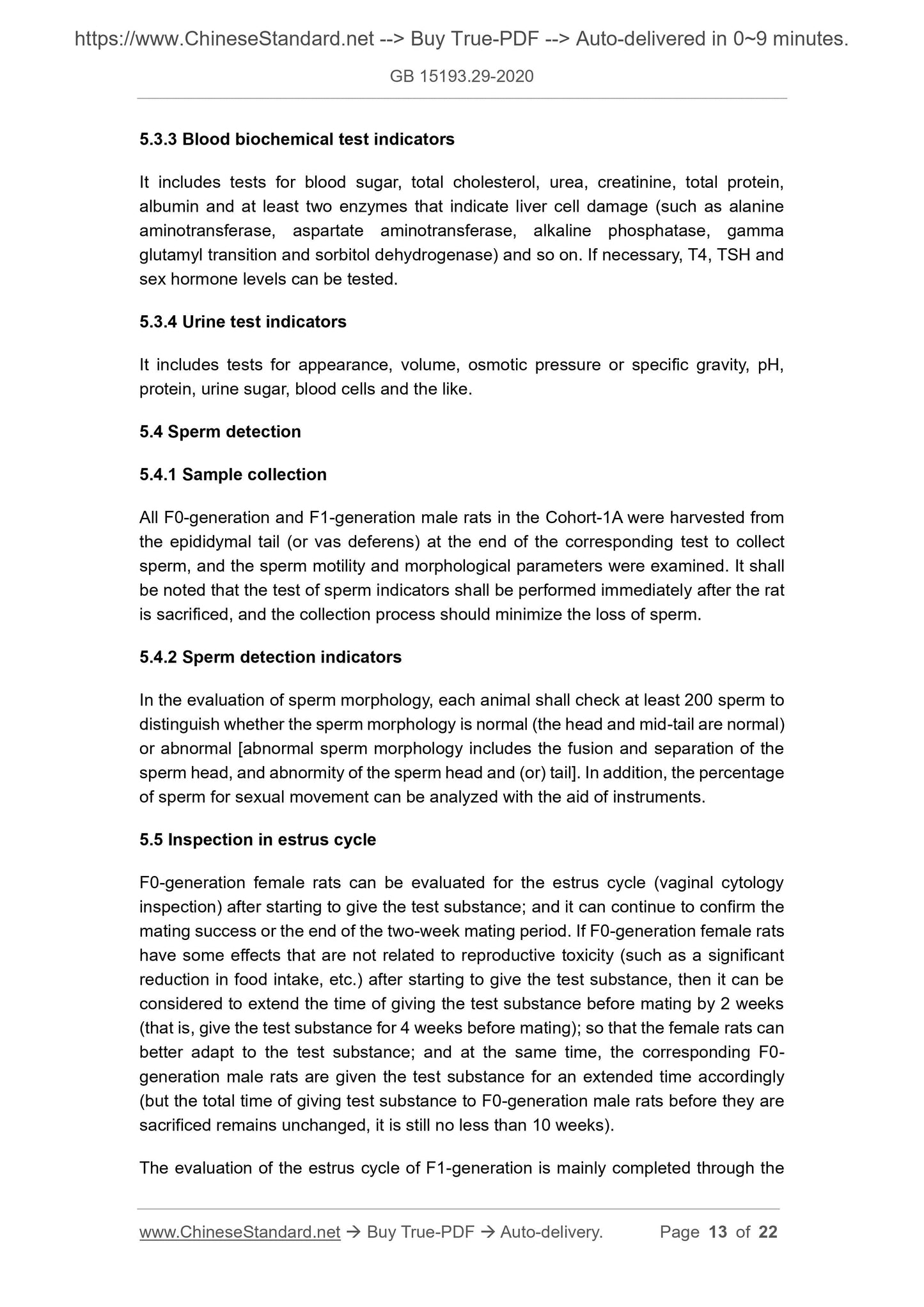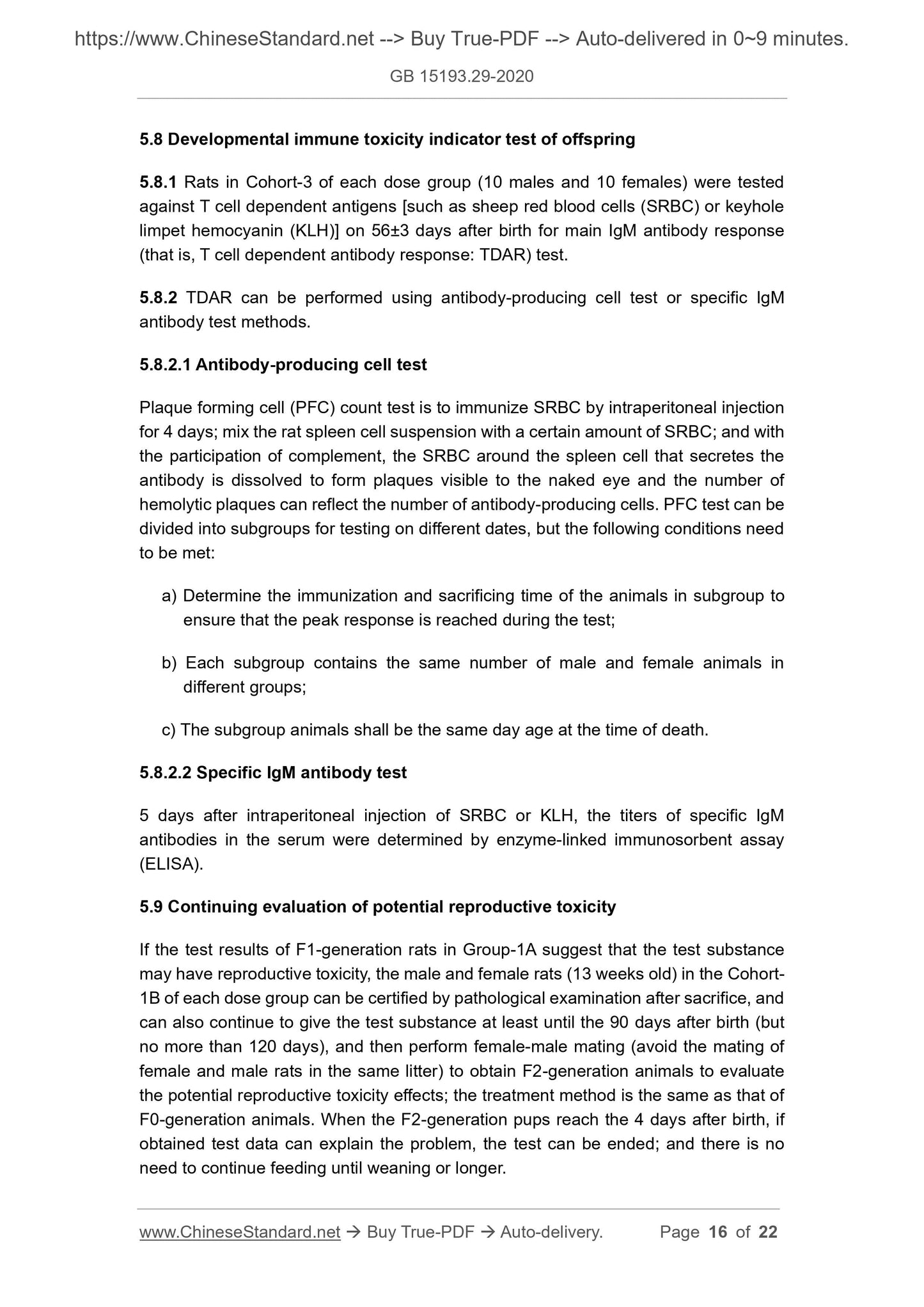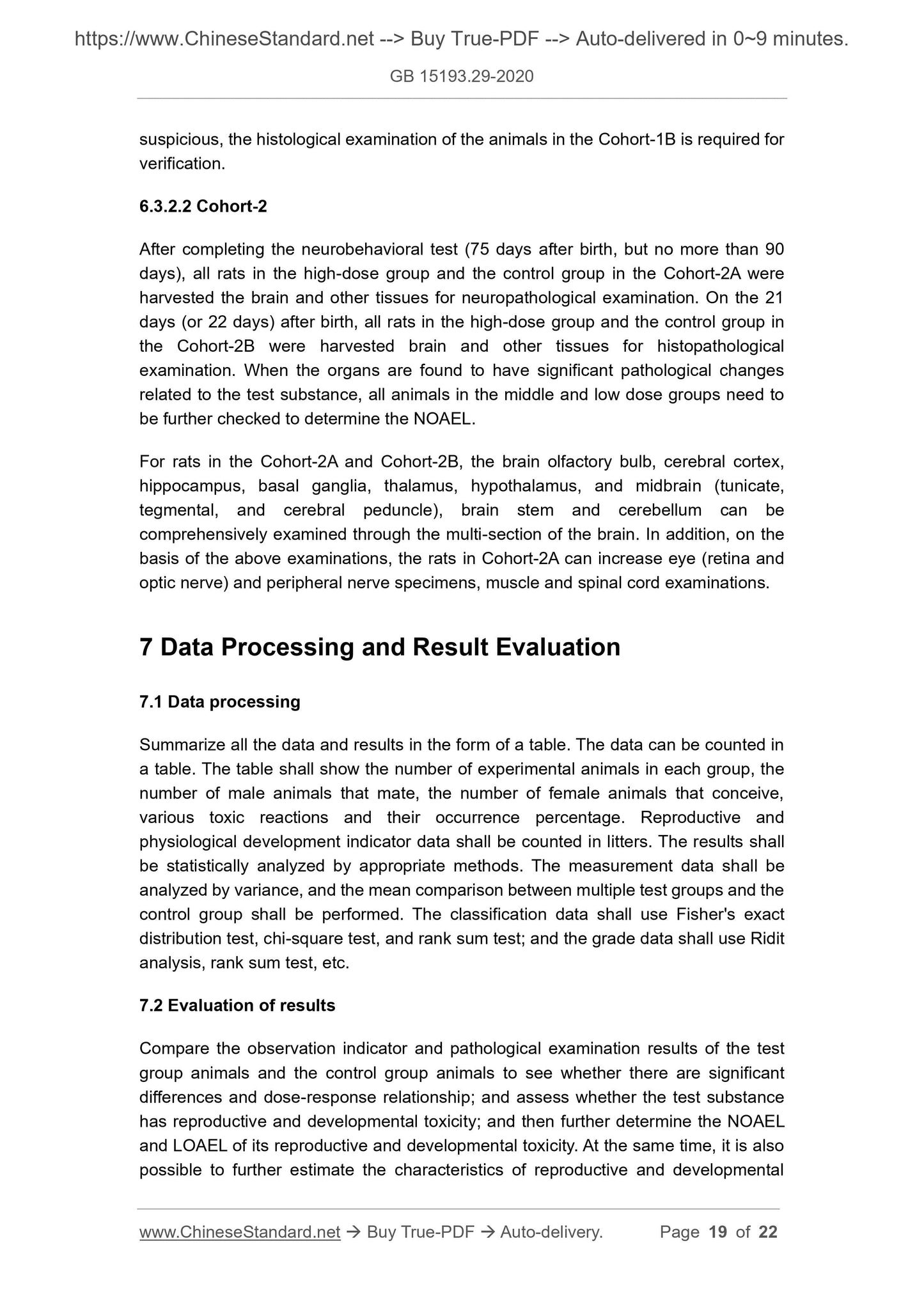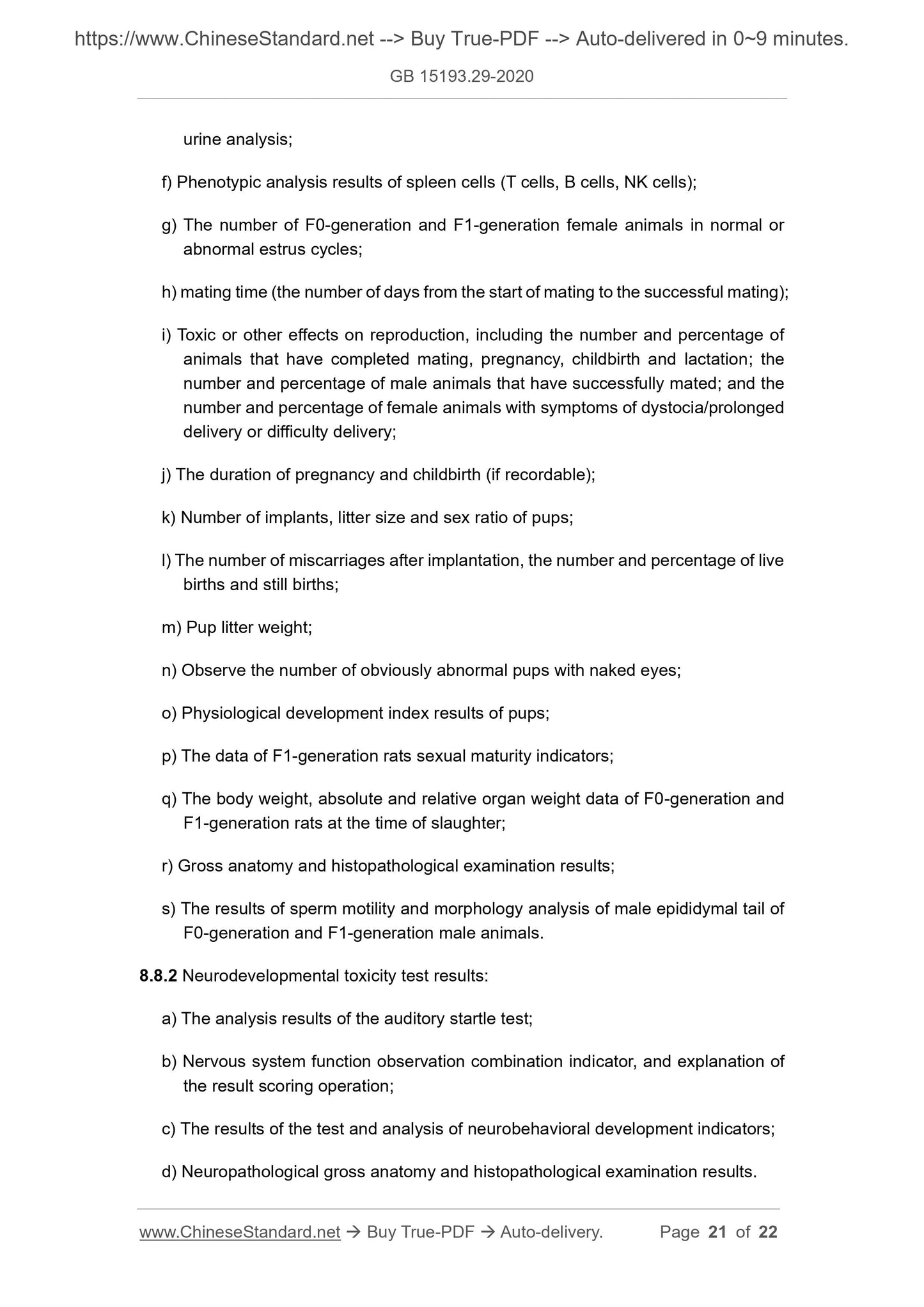1
/
von
9
PayPal, credit cards. Download editable-PDF & invoice In 1 second!
GB 15193.29-2020 English PDF (GB15193.29-2020)
GB 15193.29-2020 English PDF (GB15193.29-2020)
Normaler Preis
$175.00 USD
Normaler Preis
Verkaufspreis
$175.00 USD
Grundpreis
/
pro
Versand wird beim Checkout berechnet
Verfügbarkeit für Abholungen konnte nicht geladen werden
Delivery: 3 seconds. Download true-PDF + Invoice.
Get QUOTATION in 1-minute: Click GB 15193.29-2020
Historical versions: GB 15193.29-2020
Preview True-PDF (Reload/Scroll if blank)
GB 15193.29-2020: National food safety standard - Test of extended one-generation reproductive toxicity
GB 15193.29-2020
GB
NATIONAL STANDARD OF THE
PEOPLE’S REPUBLIC OF CHINA
National Food Safety Standard - Test of
Extended One-Generation Reproductive Toxicity
ISSUED ON: SEPTEMBER 11, 2020
IMPLEMENTED ON: MARCH 11, 2021
Issued by: National Health Commission of the PRC;
State Administration for Market Regulation.
Table of Contents
1 Scope ... 3
2 Terms and Definitions ... 3
3 Purpose of Test ... 4
4 Test Methods ... 4
5 Observation Indicators ... 11
6 Pathological Examination ... 17
7 Data Processing and Result Evaluation ... 19
8 Test Report ... 20
9 Interpretation of the Test ... 22
National Food Safety Standard - Test of
Extended One-Generation Reproductive Toxicity
1 Scope
This Standard specifies the basic test methods and technical requirements for the
extended one-generation reproductive toxicity.
This Standard is applicable to the evaluation of the reproductive and developmental
toxicity of the test substance.
2 Terms and Definitions
2.1 Reproductive toxicity
Damage to male and female reproductive function or ability, and harmful effects on
offspring. Reproductive toxicity may occur in female’s pregnancy period, as well as in
pre-pregnancy and lactation. It is manifested as the influence of exogenous chemicals
on the reproductive process, such as changes in the reproductive organs and
endocrine system, the influence on the sexual cycle and sexual behavior, as well as
the influence on fertility and pregnancy outcome.
2.2 Developmental toxicity
The harmful effects of individuals exposed to the test substance before birth and before
they develop into adults (including embryonic period, gestational period and after birth),
which are manifested as structural abnormalities, growth changes, functional defects
and death of the developing organism.
2.3 Nerve developmental toxicity
The abnormal changes in the structure and function of the nervous system caused by
the exposure of the individual to the test substance during the development process,
which may occur at any stage of the life cycle.
2.4 Developmental immunotoxicity
The immune system development is affected and dysfunction occurs, which are
caused by exposure to the test substance during the early development of the
individual's life (especially before and after birth), and these effects are not detected or
have a short duration when the adult individual is exposed.
to be sensitive to the test substance. Generally, rodents are preferred to choose rats,
and avoid strains with low reproductive rate or high incidence of developmental defects.
The principles and recommendations in this Standard are based on rats. In order to
correctly evaluate the influence of the test substance on the reproductive and
developmental abilities of animals, animals of both sexes shall be used. The selected
animals should indicate species, strain, sex, weight and age in weeks. The weight
difference between the experimental animals of the same sex does not exceed ±20%
of the average weight. The selected parental experimental animals must be sexually
mature at the beginning of the test, and must be similar in age (day) to mating (rats are
at least 13 weeks old), and the female animals shall be non-parous and non-pregnant
animals.
4.2.2 The number of experimental animals
In order to obtain the basic test data with statistical requirements, correctly evaluate
the toxic effect of the test substance on the reproduction and development process of
the animal (including the reproduction, pregnancy and feeding process of the F0-
generation animal; and the growth and development of the F1-generation animal from
birth to maturity); it is necessary to ensure that at least 20 pregnant mice are obtained
in each dose group and control group of the test substance. Generally, at the beginning
of the test, it is recommended to prepare about 30 rats for each group of parental
generation (F0-generation) rats of two sexes.
4.2.3 Preparation of animal
Before the test, the animals shall undergo at least 3d~5d of environmental adaptation
and quarantine observation in the experimental animal room.
4.2.4 Animal breeding environment
The breeding conditions, drinking water, and feed of experimental animals shall comply
with the relevant provisions of GB 14925, GB 5749, and GB 14924. Experimental
animals are raised in single cage or separated by sex; and they may eat and drink
freely. When pregnant rats are near delivery, they shall be raised separately in
farrowing cages; and appropriate litter for nesting shall be placed in the cages when
necessary.
4.3 Dose and grouping
Animals are randomly grouped according to their body weight; there are at least 3 test
substance dose groups and 1 control group. If the test substance uses a solvent, the
control group shall be given the maximum amount of the used solvent. The design of
high-dose test substance group for certain test substances shall consider its impact on
nutrient balance; and the dose of non-nutritive test substances shall not exceed 5% of
the feed.
with carboxymethyl cellulose, starch, etc. Dissolvents or other additives to enhance
the solubility of the test substance shall consider the following characteristics: whether
it affects the absorption, distribution, metabolism and retention of the test substance;
whether it affects the chemical properties of the test substance, so as to change its
toxicity characteristics; whether it affects animal food and water consumption and
affect the nutritional level of animals. In addition, in addition to water, the toxicity
characteristics of solvents must be clear; and avoid the use of potentially toxic solvents
(such as acetone, dimethyl sulfoxide). The test substance shall be prepared for
immediate use, unless there is data showing that its solution or suspension is stable
in storage.
4.4.5 The test substance is administered by gavage, if the dissolvent is an aqueous
solution, the gavage volume shall generally not exceed 10mL/kg body weight; and the
maximum gavage volume shall not exceed 20mL/kg body weight. If the dissolvent is
an oily liquid, the gavage volume shall not exceed 4mL/kg body weight. The intragastric
volume of each group shall be the same. The gavage shall be given once a day at the
same time; weighing at least twice a week; and the gavage volume shall be adjusted
according to the body weight. It is recommended not to gavage the mother rats or take
other treatment measures on the day of delivery.
4.5 Test method
It is recommended to select female and male rats over 10 weeks of age as the F0-
generation; and start to give the test substance after at least 3~5 days of adaptation.
The F0-generation female and male rats in each group shall be treated in the same
way. The test substance shall be given every day for the duration of the experiment
starting from 2 weeks before mating and covering the mating period, pregnancy period
and F1-generation weaning. After the F1-generation is weaned, the F0-generation
female and male rats can be subjected to the test of gross anatomy and reproductive
indicators; but it is necessary to ensure that the F0-generation male rats are exposed
to the test substance for no less than 10 weeks (at least 1 complete spermatogenesis
process). F1-generation female and male offspring after weaning in each group were
randomly assigned to each evaluation cohort of the group according to the test purpose;
and the test substance was given until the corr...
Get QUOTATION in 1-minute: Click GB 15193.29-2020
Historical versions: GB 15193.29-2020
Preview True-PDF (Reload/Scroll if blank)
GB 15193.29-2020: National food safety standard - Test of extended one-generation reproductive toxicity
GB 15193.29-2020
GB
NATIONAL STANDARD OF THE
PEOPLE’S REPUBLIC OF CHINA
National Food Safety Standard - Test of
Extended One-Generation Reproductive Toxicity
ISSUED ON: SEPTEMBER 11, 2020
IMPLEMENTED ON: MARCH 11, 2021
Issued by: National Health Commission of the PRC;
State Administration for Market Regulation.
Table of Contents
1 Scope ... 3
2 Terms and Definitions ... 3
3 Purpose of Test ... 4
4 Test Methods ... 4
5 Observation Indicators ... 11
6 Pathological Examination ... 17
7 Data Processing and Result Evaluation ... 19
8 Test Report ... 20
9 Interpretation of the Test ... 22
National Food Safety Standard - Test of
Extended One-Generation Reproductive Toxicity
1 Scope
This Standard specifies the basic test methods and technical requirements for the
extended one-generation reproductive toxicity.
This Standard is applicable to the evaluation of the reproductive and developmental
toxicity of the test substance.
2 Terms and Definitions
2.1 Reproductive toxicity
Damage to male and female reproductive function or ability, and harmful effects on
offspring. Reproductive toxicity may occur in female’s pregnancy period, as well as in
pre-pregnancy and lactation. It is manifested as the influence of exogenous chemicals
on the reproductive process, such as changes in the reproductive organs and
endocrine system, the influence on the sexual cycle and sexual behavior, as well as
the influence on fertility and pregnancy outcome.
2.2 Developmental toxicity
The harmful effects of individuals exposed to the test substance before birth and before
they develop into adults (including embryonic period, gestational period and after birth),
which are manifested as structural abnormalities, growth changes, functional defects
and death of the developing organism.
2.3 Nerve developmental toxicity
The abnormal changes in the structure and function of the nervous system caused by
the exposure of the individual to the test substance during the development process,
which may occur at any stage of the life cycle.
2.4 Developmental immunotoxicity
The immune system development is affected and dysfunction occurs, which are
caused by exposure to the test substance during the early development of the
individual's life (especially before and after birth), and these effects are not detected or
have a short duration when the adult individual is exposed.
to be sensitive to the test substance. Generally, rodents are preferred to choose rats,
and avoid strains with low reproductive rate or high incidence of developmental defects.
The principles and recommendations in this Standard are based on rats. In order to
correctly evaluate the influence of the test substance on the reproductive and
developmental abilities of animals, animals of both sexes shall be used. The selected
animals should indicate species, strain, sex, weight and age in weeks. The weight
difference between the experimental animals of the same sex does not exceed ±20%
of the average weight. The selected parental experimental animals must be sexually
mature at the beginning of the test, and must be similar in age (day) to mating (rats are
at least 13 weeks old), and the female animals shall be non-parous and non-pregnant
animals.
4.2.2 The number of experimental animals
In order to obtain the basic test data with statistical requirements, correctly evaluate
the toxic effect of the test substance on the reproduction and development process of
the animal (including the reproduction, pregnancy and feeding process of the F0-
generation animal; and the growth and development of the F1-generation animal from
birth to maturity); it is necessary to ensure that at least 20 pregnant mice are obtained
in each dose group and control group of the test substance. Generally, at the beginning
of the test, it is recommended to prepare about 30 rats for each group of parental
generation (F0-generation) rats of two sexes.
4.2.3 Preparation of animal
Before the test, the animals shall undergo at least 3d~5d of environmental adaptation
and quarantine observation in the experimental animal room.
4.2.4 Animal breeding environment
The breeding conditions, drinking water, and feed of experimental animals shall comply
with the relevant provisions of GB 14925, GB 5749, and GB 14924. Experimental
animals are raised in single cage or separated by sex; and they may eat and drink
freely. When pregnant rats are near delivery, they shall be raised separately in
farrowing cages; and appropriate litter for nesting shall be placed in the cages when
necessary.
4.3 Dose and grouping
Animals are randomly grouped according to their body weight; there are at least 3 test
substance dose groups and 1 control group. If the test substance uses a solvent, the
control group shall be given the maximum amount of the used solvent. The design of
high-dose test substance group for certain test substances shall consider its impact on
nutrient balance; and the dose of non-nutritive test substances shall not exceed 5% of
the feed.
with carboxymethyl cellulose, starch, etc. Dissolvents or other additives to enhance
the solubility of the test substance shall consider the following characteristics: whether
it affects the absorption, distribution, metabolism and retention of the test substance;
whether it affects the chemical properties of the test substance, so as to change its
toxicity characteristics; whether it affects animal food and water consumption and
affect the nutritional level of animals. In addition, in addition to water, the toxicity
characteristics of solvents must be clear; and avoid the use of potentially toxic solvents
(such as acetone, dimethyl sulfoxide). The test substance shall be prepared for
immediate use, unless there is data showing that its solution or suspension is stable
in storage.
4.4.5 The test substance is administered by gavage, if the dissolvent is an aqueous
solution, the gavage volume shall generally not exceed 10mL/kg body weight; and the
maximum gavage volume shall not exceed 20mL/kg body weight. If the dissolvent is
an oily liquid, the gavage volume shall not exceed 4mL/kg body weight. The intragastric
volume of each group shall be the same. The gavage shall be given once a day at the
same time; weighing at least twice a week; and the gavage volume shall be adjusted
according to the body weight. It is recommended not to gavage the mother rats or take
other treatment measures on the day of delivery.
4.5 Test method
It is recommended to select female and male rats over 10 weeks of age as the F0-
generation; and start to give the test substance after at least 3~5 days of adaptation.
The F0-generation female and male rats in each group shall be treated in the same
way. The test substance shall be given every day for the duration of the experiment
starting from 2 weeks before mating and covering the mating period, pregnancy period
and F1-generation weaning. After the F1-generation is weaned, the F0-generation
female and male rats can be subjected to the test of gross anatomy and reproductive
indicators; but it is necessary to ensure that the F0-generation male rats are exposed
to the test substance for no less than 10 weeks (at least 1 complete spermatogenesis
process). F1-generation female and male offspring after weaning in each group were
randomly assigned to each evaluation cohort of the group according to the test purpose;
and the test substance was given until the corr...
Share
